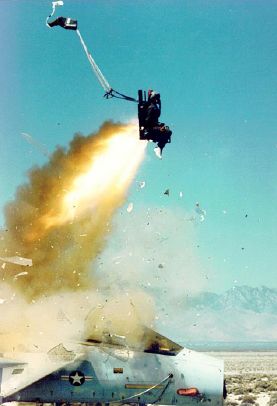An ejection seat is an emergency, last-ditch, all-else-has-failed alternative to death.
In aircraft, an ejection seat is a system designed to rescue the pilot or other crew of an aircraft in an emergency. In most designs, the aircraft canopy comes off and the seat is propelled out of the aircraft by an explosive charge or rocket motor, carrying the pilot with it. Once clear of the aircraft, the ejection seat deploys a parachute. In two-seat aircraft, the seats are ejected at different angles to avoid a collision.
Before ejection seats, pilots would have to remove the aircraft canopy manually to climb and jump out.
Ejection seats can save lives. However, they are not used in commercial passenger aircraft. Why?
‘OK… there are a few things that you aren’t aware of when it comes to ejection seats,’ says Jeff Chatterton, Communications Consultant to 7 Aviation Companies, on Quora.
‘a) Most pilots, IF they ever eject from a plane, will eject ONCE in their life.
‘An ejection seat is an emergency, last-ditch, all-else-has-failed alternative to death. That’s about it. It’s not at all uncommon for ejected pilots to suffer massive spinal damage, broken limbs, and road rash… the list of injuries that can occur as a result of ejection are numerous.
‘Having spinal damage sucks. But it beats dying.
‘b) Most pilots are healthy, 20–35-year-old males.
‘Can you imagine the consequences of ejecting an 85-year-old grandmother? What about a 4-year-old boy? What about lap infants?
‘c) An ejection seat is a bomb.
‘When that handle gets pulled, the seat literally explodes out of the plane. In the space of microseconds, explosive bolts rip open the canopy above the pilot’s head, and then a rocket under his seat ignites, launching the pilot into the air. The pilot is braced for impact and in the proper launch position.

‘Now imagine filling a commercial jetliner with 300+ of these things. Heck – TSA gets upset if I bring scissors onto a plane…
‘d) They’re INCREDIBLY expensive and heavy.
‘Remember – this is a bomb. Fighter pilots can use it because they only need to eject 50 feet into the air… and fighter jets have nothing but thrust. A fighter jet is basically an engine with wings to steer it. Fighter jets can handle the weight. On a commercial jetliner where every pound of cargo requires extra fuel, this simply isn’t possible.’
Chatterton continues;
‘e) It’s not necessary.
‘For every accident like Ethiopian Airlines, we’d have 10 ‘inadvertent detonations.’ (And now that we’ve punched a giant hole into our fuselage at altitude, we’ve got a host of other problems.)
‘A passenger airline is incredibly safe. Can you imagine what would have happened to US Airways 1549 if Chesley Sullenberger ordered everyone to eject? This was the infamous ‘Miracle on the Hudson.’

‘Instead of pictures like this, with a bunch of alive passengers, we’d have stories of Grandma hanging in a chute off the Empire State building… Babies getting run over by taxi cabs… people smacking into the side of buildings and falling to their death… people landing in the Hudson and drowning because they’re on their own and unable to be assisted…
‘f) The public would REVOLT.
‘People already complain about lack of legroom or flight attendants getting snarky about the seatbelt sign. Now imagine taking a 6-hour flight where you’re strapped into this?

‘No. Let’s keep everyone where they’re safest. Inside the plane.
‘g) A high-speed, high-altitude ejection would rip your clothes off.
‘(And you’d need oxygen for the entire descent.) Let’s just leave the oxygen issue aside. Let’s assume that through modern magic, you can breathe from 40,000 feet. But look around you after you’ve ejected… remember that 280-pound sales guy with bad breath? He’s hanging under a chute… naked. The old lady who tried to poach your seat? Hanging out beside you, naked. The teenage boy with acne and confidence issues has his clothes in shreds hanging off him…’
Chatterton concludes;
‘Oh – by the way, even if you can breathe… it’s well below freezing.’
Photo by U.S. Air Force, Greg L, and Sandstein via Wikipedia

